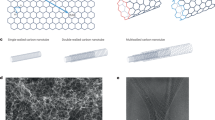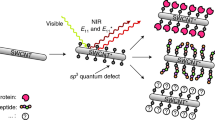Abstract
Nanoscale sensing elements offer promise for single-molecule analyte detection in physically or biologically constrained environments. Single-walled carbon nanotubes have several advantages when used as optical sensors1,2,3, such as photostable near-infrared emission for prolonged detection through biological media2,4,5 and single-molecule sensitivity6. Molecular adsorption can be transduced into an optical signal by perturbing the electronic structure of the nanotubes7. Here, we show that a pair of single-walled nanotubes provides at least four modes that can be modulated to uniquely fingerprint agents by the degree to which they alter either the emission band intensity or wavelength. We validate this identification method in vitro by demonstrating the detection of six genotoxic analytes, including chemotherapeutic drugs and reactive oxygen species, which are spectroscopically differentiated into four distinct classes, and also demonstrate single-molecule sensitivity in detecting hydrogen peroxide. Finally, we detect and identify these analytes in real time within live 3T3 cells, demonstrating multiplexed optical detection from a nanoscale biosensor and the first label-free tool to optically discriminate between genotoxins.
This is a preview of subscription content, access via your institution
Access options
Subscribe to this journal
Receive 12 print issues and online access
$259.00 per year
only $21.58 per issue
Buy this article
- Purchase on Springer Link
- Instant access to full article PDF
Prices may be subject to local taxes which are calculated during checkout




Similar content being viewed by others
References
Barone, P. W., Baik, S., Heller, D. A. & Strano, M. S. Near-infrared optical sensors based on single-walled carbon nanotubes. Nature Mater. 4, 86–92 (2005).
Saito, R., Dresselhaus, G. & Dresselhaus, M. S. Physical Properties of Carbon Nanotubes (Imperial College Press, 1998).
Heller, D. A. et al. Optical detection of DNA conformational polymorphism on single-walled carbon nanotubes. Science 311, 508–511 (2006).
O'Connell, M. J. et al. Band gap fluorescence from individual single-walled carbon nanotubes. Science 297, 593–596 (2002).
Lefebvre, J., Austing, D. G., Bond, J. & Finnie, P. Photoluminescence imaging of suspended single-walled carbon nanotubes. Nano Lett. 6, 1603–1608 (2006).
Cognet, L. et al. Stepwise quenching of exciton fluorescence in carbon nanotubes by single-molecule reactions. Science 316, 1465–1468 (2007).
Dukovic, G. et al. Reversible surface oxidation and efficient luminescence quenching in semiconductor single-wall carbon nanotubes. J. Am. Chem. Soc. 126, 15269–15276 (2004).
Choi, J. H. & Strano, M. S. Solvatochromism in single-walled carbon nanotubes. Appl. Phys. Lett. 90, 223114 (2007).
Rhee, S. G. H2O2, a necessary evil for cell signaling. Science 312, 1882–1883 (2006).
Povirk, L. F. & Shuker, D. E. DNA damage and mutagenesis induced by nitrogen mustards. Mutat. Res. Rev. Genet. 318, 205–226 (1994).
Delalande, O., Malina, J., Brabec, V. & Kozelka, J. Chiral differentiation of DNA adducts formed by enantiomeric analogues of antitumor cisplatin is sequence-dependent. Biophys. J. 88, 4159–4169 (2005).
Tilby, M. J. et al. A monofunctional derivative of melphalan: Preparation, DNA alkylation products and determination of the specificity of monoclonal antibodies that recognize melphalan–DNA adducts. Chem. Res. Toxicol. 11, 1162–1168 (1998).
Lovell, M. A. & Markesbery, W. R. Ratio of 8-hydroxyguanine in intact DNA to free 8-hydroxyguanine is increased in Alzheimer disease ventricular cerebrospinal fluid. Arch. Neurol. 58, 392–396 (2001).
Hamilton, M. L. et al. Does oxidative damage to DNA increase with age? Proc. Natl Acad. Sci. USA 98, 10469–10474 (2001).
Kawanishi, S., Hiraku, Y., Murata, M. & Oikawa, S. The role of metals in site-specific DNA damage with reference to carcinogenesis. Free Radic. Biol. Med. 32, 822–832 (2002).
Imlay, J. A. Pathways of oxidative damage. Annu. Rev. Microbiol. 57, 395–418 (2003).
Aruoma, O. I., Halliwell, B., Gajewski, E. & Dizdaroglu, M. Copper-ion-dependent damage to the bases in DNA in the presence of hydrogen peroxide. Biochem. J. 273, 601–604 (1991).
Zheng, M. et al. DNA-assisted dispersion and separation of carbon nanotubes. Nature Mater. 2, 338–342 (2003).
Jackson, E. J. A User's Guide to Principal Components (John Wiley & Sons, 2003).
Song, C. H., Pehrsson, P. E. & Zhao, W. Recoverable solution reaction of HiPco carbon nanotubes with hydrogen peroxide. J. Phys. Chem. B 109, 21634–21639 (2005).
Tu, X. M., Pehrsson, P. E. & Zhao, W. Redox reaction of DNA-encased HiPCO carbon nanotubes with hydrogen peroxide: A near infrared optical sensitivity and kinetics study. J. Phys. Chem. C 111, 17227–17231 (2007).
Burrows, C. J. & Muller, J. G. Oxidative nucleobase modifications leading to strand scission. Chem. Rev. 98, 1109–1151 (1998).
Duguid, J., Bloomfield, V. A., Benevides, J. & Thomas, G. J. Raman spectroscopy of DNA-metal complexes. 1. Interactions and conformational effects of the divalent-cations — Mg, Ca, Sr, Ba, Mn, Co, Ni, Cu, Pd and Cd. Biophys. J. 65, 1916–1928 (1993).
Lloyd, D. R. & Phillips, D. H. Oxidative DNA damage mediated by copper(II), iron(II) and nickel(II) Fenton reactions: evidence for site-specific mechanisms in the formation of double-strand breaks, 8-hydroxydeoxyguanosine and putative intrastrand cross-links. Mutat. Res. Fund. Mol. M. 424, 23–36 (1999).
Yang, J. L., Wang, L. C., Chang, C. Y. & Liu, T. Y. Singlet oxygen is the major species participating in the induction of DNA strand breakage and 8-hydroxydeoxyguanosine adduct by lead acetate. Environ. Mol. Mutagen. 33, 194–201 (1999).
Kerssemakers, J. W. J. et al. Assembly dynamics of microtubules at molecular resolution. Nature 442, 709–712 (2006).
Kam, N. W. S., O'Connell, M., Wisdom, J. A. & Dai, H. J. Carbon nanotubes as multifunctional biological transporters and near-infrared agents for selective cancer cell destruction. Proc. Natl Acad. Sci. USA 102, 11600–11605 (2005).
Cherukuri, P., Bachilo, S. M., Litovsky, S. H. & Weisman, R. B. Near-infrared fluorescence microscopy of single-walled carbon nanotubes in phagocytic cells. J. Am. Chem. Soc. 126, 15638–15639 (2004).
Heller, D. A., Baik, S., Eurell, T. E. & Strano, M. S. Single-walled carbon nanotube spectroscopy in live cells: Towards long-term labels and optical sensors. Adv. Mater. 17, 2793–2799 (2005).
Gaetani, G. F. et al. Predominant role of catalase in the disposal of hydrogen peroxide within human erythrocytes. Blood 87, 1595–1599 (1996).
Jin, H., Heller, D. A. & Strano, M. S. Single-particle tracking of endocytosis and exocytosis of single-walled carbon nanotubes in NIH-3T3 cells. Nano Lett. 8, 1577–1585 (2008).
Jin, H. et al. Divalent ion and thermally induced DNA conformational polymorphism on single-walled carbon nanotubes. Macromolecules 40, 6731–6739 (2007).
Acknowledgements
M.S.S is grateful for a Beckman Young Investigator Award and a National Science Foundation (NSF) Career Award. This work was funded under the NSF Nanoscale Interdisciplinary Research Team on single molecule detection in living cells using carbon nanotube optical probes. The authors thank S. McMasters (University of Illinois) for cell culture assistance, and C. Fantini, A. Jain, A. Moll and J. Ossyra for experimental assistance. We also thank S. Tannenbaum, G. Wogan and L. Trudel and acknowledge a seed grant from the Center for Environmental Health Sciences at MIT. Partial support was provided by the National Cancer Institute (U54-CA119342-01) to the Siteman Center of Cancer Nanotechnology Excellence, through the University of Illinois Center for Nanoscale Science and Technology.
Author information
Authors and Affiliations
Contributions
D.H. and M.S. originated the concept for the paper and the experimental validation. D.H., H.J., B.M., D.P., B.M., T.-K.Y., P.J. and C.H. all assisted in the experiments. D.H., B.M., D.P., B.M., T.-K.Y., P.J. and C.H. performed the data analysis. S.S., T.H., C.H. and P.J. contributed materials/specific analysis tools and provided useful discussions. D.H. and M.S. co-wrote the paper with input from S.S.
Corresponding author
Supplementary information
Supplementary Information
Supplementary Information (PDF 661 kb)
Supplementary Information
Supplementary Movie (MOV 722 kb)
Rights and permissions
About this article
Cite this article
Heller, D., Jin, H., Martinez, B. et al. Multimodal optical sensing and analyte specificity using single-walled carbon nanotubes. Nature Nanotech 4, 114–120 (2009). https://doi.org/10.1038/nnano.2008.369
Received:
Accepted:
Published:
Issue Date:
DOI: https://doi.org/10.1038/nnano.2008.369



